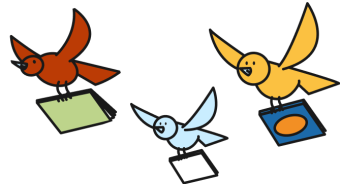
Lyrical language and artful illustrations present the life of a lotus and the resilience it represents. A lotus seed falls into the soil and drifts into a deep sleep. It awakens, unfurling tender buds and wide green leaves. Then, the flower blooms, its brilliant petals opening to the sun. And soon enough, another lotus seed falls, starting the cycle all over again… This is a book to share with children of different ages.
The Water Flower: The Journey of a Lotus Seed

Travel the world through traditional stories, just right to read aloud and share with children of different ages. Featuring stories of mermaids, ocean gods, magical fish and majestic dragons, there is something for everyone in this collection of tales inspired by watery worlds.
An Ocean Full of Stories: 50 Folktales and Legends from Around the World
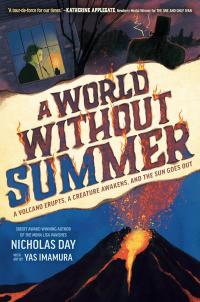
Dramatic descriptions of the eruption of Indonesia’s Mount Tambora in the early 19th century open this compelling story of Earth’s warning signs, often left unheeded by humankind. This is the true story of how a massive catastrophic eruption plunged the world into darkness, altering the global climate and inspiring the likes of Mary Shelley’s Frankenstein. Black and white sketches enhance the compelling presentation which is fully sourced and documented.
A World Without Summer: A Volcano Erupts, A Creature Awakens, and the Sun Goes Out
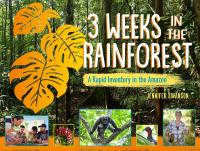
Visit the Andes Amazon with a group of scientists from Chicago’s Field Museum who work with local people to collect information about the plants and animals at specific sites. A conversational narrative and full-color photographs document the work which is realistic but optimist about environmental threats. Additional information is included.
3 Weeks in the Rainforest: A Rapid Inventory in the Amazon

Max accompanies his mother on a research trip to the Texas Gulf Coast. There he finds a beached octopus and works with others to rescue her. Named Ursula, the octopus helps Max come into his own in this moving, realistic story.
Three Blue Hearts
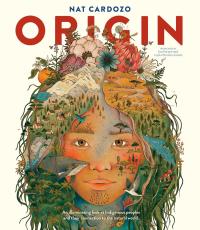
It starts with a question: what do Indigenous people from around the world share? The answer: the planet we all live on and a deep respect for it. Stunning portraits of individuals are overlayed with images reflecting their land and customs. This beautiful, oversized look at our world is not to be missed.
Origin
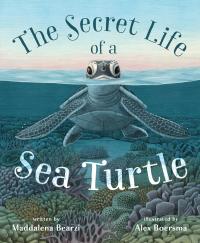
The life of a sea turtle born at the Ría Lagartos nature reserve in Mexico is dramatically presented in realistic yet expressive illustrations and carefully crafted narration. A note from the author describes her interest in wildlife and suggests tangible ways to help sea life. Additional information is also presented.
The Secret Life of a Sea Turtle
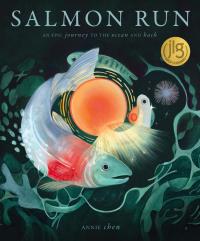
Stunning illustrations chronicle the growth and life of a Coho salmon from its birth on Day 1 on the Duwamish River in Washington to Days 1380–1450 when she lays eggs of her own. Additional information, including a QR code that provides more information on Coho salmon, concludes this gorgeous book.
Salmon Run: An Epic Journey to the Ocean and Back
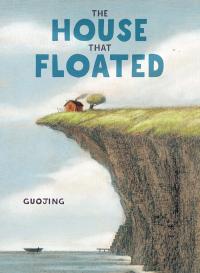
Structured like a graphic novel, sequential panels of painterly illustrations portray a family living in a home by the sea. Ultimately, the sea rises and so the family must move the house. [An author’s note in Pencil by Hye-eun Kim — an evocative tale of a pencil’s journey from tree to tool — describes how to successfully share a “silent book.”]
The House That Floated
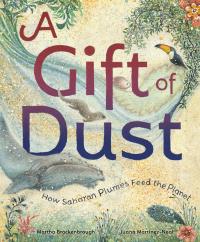
“Once, each speck was something else: dirt, pollen, or a bit of a living thing traveling someplace new.” Dust plumes are fascinatingly presented through lyrical language and textured illustrations. Dust plumes feed sea creatures, can weigh as much as billions of basketballs, and can be seen from space. Additional resources are included in this gorgeous book sure to engage and inspire readers.
A Gift of Dust: How Saharan Plumes Feed the Planet
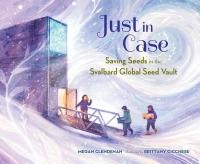
On an island in Norway, “away from wars and weapons, safe from earthquakes, fire, and even an asteroid” a collection of seeds is preserved underground. How the seed vault was constructed is presented in attractive illustration and an accessible text accompanied by sidebars with additional information. Resources and further information are included.
Just in Case: Saving Seeds in the Svalbard Global Seed Vault
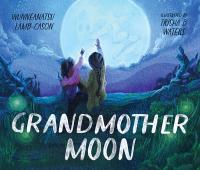
A child accompanies her grandmother — her nohhum — from the city to Nohhum’s reservation. Nohhum tells the child about the moon calendar, how to listen to the moon with her heart, and the interconnectedness of all things in this moving story from the Indigenous people of Turtle Island. Backmatter includes an author’s note and more, to learn about the different names of the full moons throughout the lunar year.
Grandmother Moon
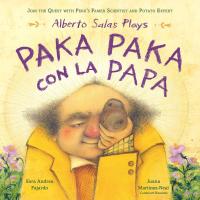
Potatoes have the power to feed the world according to Peruvian agronomist Alberto Salas. Portrayed as a chubby cheeked, balding man in warm-toned illustrations, Alberto Salas travels the Andes to play paka paka (hide and seek) with wild potatoes, working with indigenous people, and trying to get ahead of climate change. Informal text is often humorous but always informative. Also available in Spanish: Alberto Salas juega a la paka paka con la papa.
Alberto Salas Plays Paka Paka con la Papa

Peggy — an energetic toddler — and her patient grandfather go for a walk in the woods together. Peggy watches a small snail, jumps in a mud puddle, and slides down a hill, with Granddad patiently watching. When it’s time to return home, Granddad’s strong legs carry the tired child.
Peggy Goes for a Walk

A guessing game in a book that celebrates the curiosity and delight of a jaunt through a garden, meadow, and alongside a brook. A child steps outside and strolls along, taking in the sights and sounds of nature. Rhythmic, rhyming text tracks his journey through a garden, meadow, and next to a brook, introducing a new color and animal found in that ecosystem with every turn of the page, transforming an ordinary walk into a feast for the senses.
Look and Listen

Children will delight in this fantastic tale of a young girl’s vacation in the Smoky Mountains. Wandering from her tent late one summer’s night, Sara finds an invitation she just can’t resist! She watches the grand ball from safely behind a tree until suddenly she is discovered.
The Great Smoky Mountains Salamander Ball

Take a tour of Yellowstone National Park, from the wolves, elk, bears, and mountain goats that live there today to the supervolcano that erupted thousands of years ago. The poetic text takes us to the root of it all ― the “sleeping giant” of magma responsible for the Yellowstone landscape ― and the evocative paintings capture the awe of natural forces at work in our nation’s oldest national park. The addendum, “More About Yellowstone and Its Volcano,” a glossary defining geological terms, such as mud pots, steam vents, geysers, magma, and lava, and a map further aid children’s understanding of supervolcanoes.
Volcano Dreams: A Story of Yellowstone

Winner of the 1947 Caldecott Medal, this beautifully moving story centers around a little island in the midst of the wide ocean, and the curious kitten who comes to visit. As the seasons pass, the island and the creatures who call it home witness an ever-changing array of sights, smells, and sounds — proving that, no matter how small, we are all an important part of the world. Inspired by the author’s summer visits to Acadia National Park.
The Little Island

Lyrical prose and warm watercolor illustrations bring a “certain part of the country called Appalachia” alive for young readers. Two award-winning artists, forever touched by their experiences growing up in this unique landscape, have teamed to create a quietly powerful and beautifully crafted portrait of life in a timeless place. Appalachia is where you’ll find Shenandoah National Park and the Blue Ridge Mountains. Cynthia Rylant grew up in this area with her grandparents.
Appalachia: The Voices of Sleeping Birds

From tiny seed to world’s largest tree, the giant sequoia is a living wonder of nature. This ancient and tremendous species grows naturally only on the western slopes of California’s Sierra Nevada. Each sequoia begins life as a seed no larger than an oatmeal flake — yet can grow as tall as three blue whales stacked chin to tale. The oldest sequoias have lived as long as forty human lifetimes. The largest are so enormous, twenty children holding hands can’t wrap their arms around the trunks! In evocative text and vibrant paintings, The Sequoia Lives On reveals all of this fascinating information and more. An extensive author’s note completes the portrait for young readers, inviting them to become the next generation of protectors for this amazing tree.
The Sequoia Lives On

The Florida Everglades are made up of nine different ecosystems supporting an astonishing variety of wildlife ― panthers, manatees, snails, frogs, and a rainbow of bird species. But for years, the Everglades were threatened. They needed a voice to speak up for them. Marjory Stoneman Douglas became that voice. Her book “A River of Grass” helped the world see the irreplaceable beauty and value of the Everglades. Marjory’s activism led to the creation of a national park and dedicated conservation efforts, and throughout her long life she inspired countless people to use their voices to make a difference.
A Voice for the Everglades: Marjory Stoneman Douglas

Rivers wind through earth, cutting down and eroding the soil for millions of years, creating a cavity in the ground 277 miles long, 18 miles wide, and more than a mile deep known as the Grand Canyon. Home to an astonishing variety of plants and animals that have lived and evolved within its walls for millennia, the Grand Canyon is much more than just a hole in the ground. Follow a father and daughter as they make their way through the cavernous wonder, discovering life both present and past. Weave in and out of time as perfectly placed die cuts show you that a fossil today was a creature much long ago, perhaps in a completely different environment. Complete with a spectacular double gatefold, an intricate map and extensive back matter.
Grand Canyon

What’s the difference between a country and a continent? And what about a wormhole and a black hole? What’s the difference between an alligator and a crocodile? In space, on earth, in food, even in history many things are similar but are in fact quite different. Explore 150 pairs here through facts and illustration.
What’s the Actually Factually Difference?

Celebrate nature in poems by different writers and accompanied by colorful illustrations. Informational sidebars flank each poem, offering scientific context for readers, and recommended resources and a glossary are also included.
